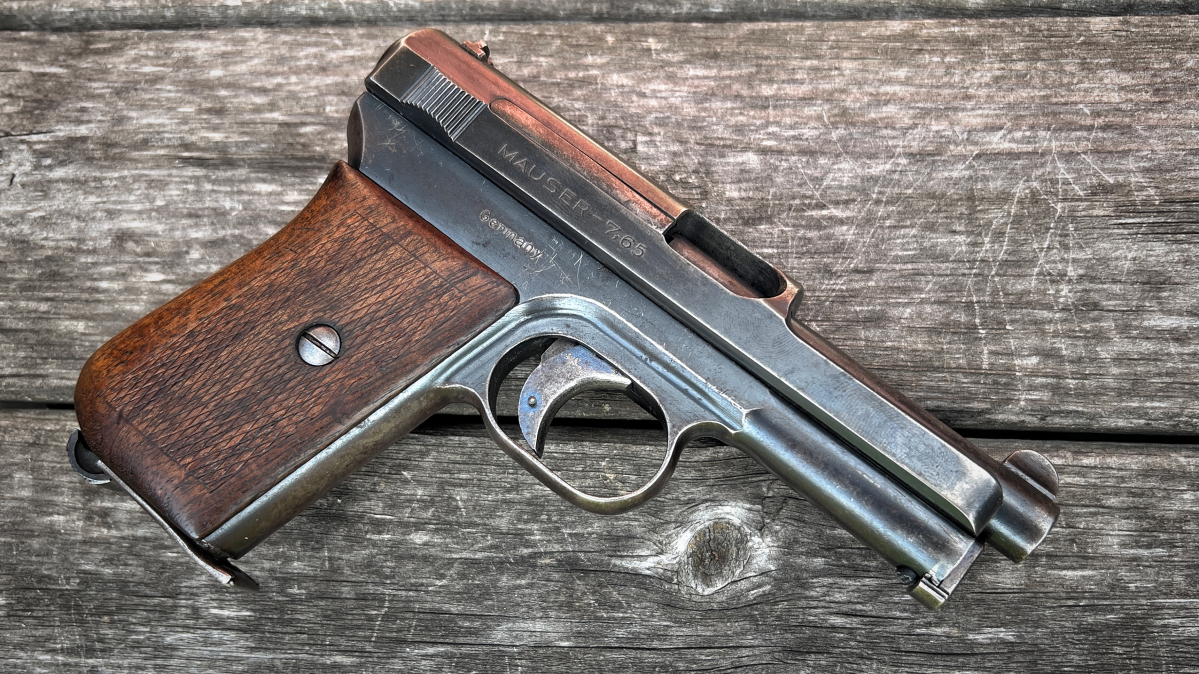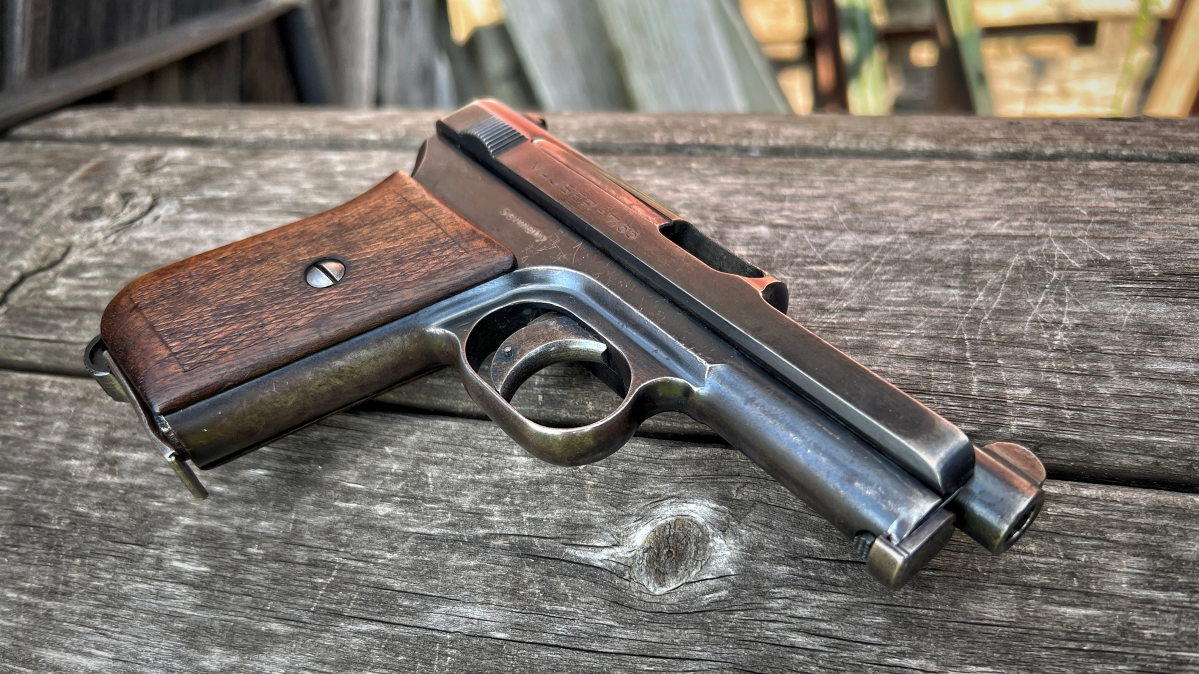Curious Relics #046: A Quiet Commercial Successes – Mauser 1914
Sam.S 08.24.22

Welcome, if you are a newcomer to this fun bi-weekly segment of AllOutdoor.com! The last time around was a pleasant surprise with a Part II to the Charter Arms Explorer II. We started out with a stand-alone article (available here) where we covered history, variations, specifications, range time, and aftermarket parts. Up until recently, I had thought that was all to write on that classic 1980s 22lr pistol. It was not until I acquired a few additional accessories to warrant the surprise Part II which is available here. Today we get to run through a Mauser pistol!
This is the Mauser 7.65 but by today’s collector definition it is the Mauser 1914. Let’s dive right in!
Welcome to our recurring series of “Curious Relics.” Here, we want to share all of our experiences, knowledge, misadventures, and passion for older firearms that one might categorize as a Curio & Relic – any firearm that is at least 50 years old according to the ATF. Hopefully along the way you can garner a greater appreciation for older firearms like we do, and simultaneously you can teach us things as well through sharing your own expertise and thoughts in the Comments. Understanding the firearms of old, their importance, and their development which lead to many of the arms we now cherish today is incredibly fascinating and we hope you enjoy what we have to share, too!
History Abridged: Mauser 1914
Starting back in the late 1890s the world was slowly getting a feel for what an autoloading pistol should be. That is in its function, operation, shape, size, feel, etc. One notable and related example would be the Mauser Construktion 96 or more well known as the Mauser C96 Broomhandle. Despite the odd sort of elegance that the C96 possessed it was quickly obvious to the Mauser company (then run by Paul Mauser) that it was not going to get adopted by many more militaries or police forces than it already was. It sort of had its moment and more ergonomic and simpler designs were popping up by the early 1900s. In 1904 Paul Mauser hired an engineer by the name of Josef Nickl.
Mr. Josef Nickl was a very promising engineer with lots of ideas to help the Mauser brand design some new more modern auto-loading handguns. His most ambitious goal was to create a handgun that could be sold in a myriad of calibers and slightly different sizes but retains the same overall appearance. Think Glock but at the start of the 1900s. By 1907 Josef began filing patents on what would become the Mauser 6.35 otherwise referred to more often as the Mauser Model 1910. Before they got there however they experimented with the newly popular 9×19 (9mm Parabellum) cartridge in the mechanism they had chosen. This did not turn out well and it was scrapped by 1909 with only a few prototypes made.
While all of that was happening they were also creating the Mauser 1910. This small pocket pistol was chambered for the 25 ACP cartridge and utilized a simple straight blowback action. The only thing decelerating and returning the slide is a simple guide rod located under the exposed barrel. The Model 1910 has a feature that is only unique to itself in that it has a slide latch that allows the user to remove the side plate to access the internal parts for maintenance. This later changed for fear that the average user would lose parts in the field. The Model 1910 pistols without the side latch are commonly referred to as the Model 1910/14. These 1910 models were trendy but the general consensus was the 25 ACP cartridge was lacking and a more popular carry cartridge would be preferred.

This request resulted in our pistol today being released in 1914 as the Mauser 7.65 or as previously mentioned the Mauser 1914. Chambered in 32 ACP and sporting an 8-round detachable magazine, this pistol would begin filling pockets in no time flat despite the outbreak of war. The FN 1900 lit the world on fire with its compact carry size and then they followed up with the sleek and stylish FN 1910. This meant that the carry gun or pocket pistol market was booming and anything new and cool was being bought.
In that sense, the Mauser 1914 sort of gets drowned out in the historical music. It is not that it sold poorly (it actually was VERY popular) it just had a lot of competitors. It should be mentioned here that very early examples of the Mauser 1914 had a swooped-down contour on the top of the slide. These models have the nickname “Humpback” as a result and are far more collectible in today’s markets given their short production run. As previously mentioned the Mauser 1914 used a straight blowback mechanism. The more notable design aspect of them is however that they use a striker system rather than the more popular hammer system. Even guns that looked similar like the Colt 1903 Pocket Hammerless utilized a hammer, albeit a hidden one.

The Mauser 1910 and Mauser 1914 had a very big presence in the pocket pistol market. It can be argued that the Mauser 1910 filled a European gap in the 25 ACP realm whereas the 32 ACP although a popular carry cartridge at the time, its design was popular with police forces around western Europe. One such aspect that improved the 32 ACP model’s sales was when World War One began. This trench-riddled hellscape of war called for every able-bodied man as well as every available small arm. One of the biggest contenders in the war had the Mauser company and its firearms at its disposal and they took advantage of that proximity. After the war ended these pistols stayed put in inventories across Europe (especially in Germany) and would become a very top-rated choice with police forces into the 1920s.
Fast forwarding to the 1930s the Mauser factory had a merger with the Luger factory and along with it came a designer that was happy to spruce up the old Mauser 1914 in a bid to make it more modern and ergonomic. This would become what is called the Mauser Model 1914/34 in collector circles. The dead giveaway is the less straight and more swept back grip to swell in the bottom of the palm. Besides this, some machining processes were streamlined and stampings were introduced to its parts. These same changes were applied to the Model 1910 (Model 1910/34).

End of Part One
The Mauser 1914 and its little brother the Mauser Model 1910 see production dates petering off in the mid 1940s toward the end of World War Two. All in all that is an absolutely ridiculous production life and it goes to show how quietly popular this gun was. Every one talks about the Luger, the FN 1910, the Colt 1903 and 1911 but no one ever really brings up these little guys because they were made in the millions. Today they are regarded as good “starter” collector pieces, a sort of collect them all handgun. Most are affordable (obviously fluctuates) and there are minor differences so they are often easily confused. Luckily my Mauser 1914 was made in the 1920s so I did not mess up when looking to purchase a true Mauser 1914. More on variants and production dating to come. See you next time with part II!
In closing, I hope our Curious Relics segment informed as well as entertained. This all was written in hopes of continued firearm appreciation and preservation. We did not just realize how guns were supposed to look and function. It was a long and tedious process that has shaped the world we live in. So, I put it to you! Is there a firearm out there that you feel does not get much notoriety? What should our next Curious Relics topic cover? As always, let us know all of your thoughts in the Comments below! We always appreciate your feedback.

